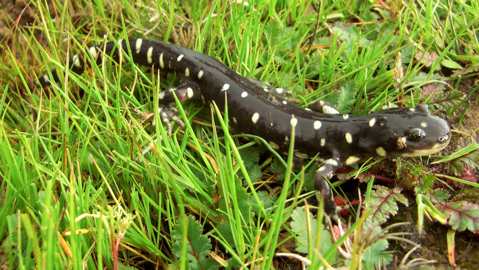Tiger Salamander Caught in the Middle
Environmentalists and Farmers Butt Heads Over Protecting the Amphibian's Future

In a state where paying the bills and getting through the recession takes priority, the fate of the California tiger salamander may be the last thing on people’s worried minds. However, this salamander has received a lot of press lately, and the longstanding battle — between conservationists and farmers — over the future of its breeding grounds has not been an easy one. After the California Fish and Game Commission was court-ordered in March of this year to list the tiger salamander (which is federally protected under the Endangered Species Act) as a threatened species, farmers and private landowners have been concerned about new guidelines that may prohibit future land development.
Kevin Merrill, president of the Santa Barbara County Farm Bureau, spoke recently to what many on that side of the fence are worried about: “It’s very difficult to take the news when you own the property, and all of a sudden you are sitting on land you can’t do much with anymore,” he said. He also stated that landowners like himself have no intentions of harming the California tiger salamander or eradicating the species off their properties, but instead are attempting to create artificial vernal pools and cattle ponds in an effort to restore breeding grounds. He went on to say, “I want the public to know that the agriculturists are not out to get rid of the tiger salamander. We just want there to be some kind of compromise with the new restrictions, so we can survive too.”
However, fragmentation and habitat loss within developed vineyards and private farms, say biologists, pose the biggest threats to tiger salamanders in Santa Barbara, and mapping surveys in the area have proven that salamander populations breed exclusively on private land. UCSB Professor Sam Sweet, who has contributed toward extensive, long-term research on the species, said, “All of the known breeding sites in Santa Barbara County are on private lands, and there is more of a conservation focus directed at breeding ponds than to the upland habitats, where the salamanders spend most of their lives.”
As California tiger salamanders depend on burrows formed by rodents as well as crevices under trees to keep from drying out during the day, research indicates that overly-developed and tilled land poses the biggest threat to native populations. It is a particularly arduous task to keep an eye on California tiger salamanders in Santa Barbara, say scientists, because the species requires the preservation of specific — though widespread — habitats throughout the county. These habitats range from high-elevation grasslands and oak forests where specimens spend most of its adult lives, to lower wetlands that the critters have been known to migrate to, for miles, to breed. Since the California salamander requires this form of wetland to breed (including the presence of vernal pools, or in some cases a slow flowing stream), it is imperative that these quickly-disappearing habitats are also conserved for the benefit of future populations, say scientists.
Alarmingly, the Center for Biological Diversity has estimated in reports that 95 percent of the area’s vernal pools have vanished, and this, combined with sprawled urbanization and loss of critical habitat, makes it very difficult for salamander populations to survive. Santa Barbara has designated approximately 11,180 acres of land as critical habitat for the California tiger salamander in the northern part of the county, but that does not include migratory zones between grasslands and wetlands, and excludes a significant amount of developed land.
Native species of the salamander mating with a non-native species — which was introduced to the area almost 60 years ago from Arizona — also poses a great danger to the survival of area populations. Sweet stressed that, “Hybrid genes spread easily and compromise the genetic integrity of native tiger salamanders. The Santa Barbara population is geographically isolated and has some unique genes, which we would prefer not to see lost.” Furthermore, he said, hybrid species thrive in this region, and prove to be a major source of competition for native species that have lower overall survival rates. Other unnatural factors have also been proven to adversely affect populations, as surveys indicate that predation from introduced fish and bullfrogs are another major concern for breeding areas.
All of these factors have thus increased the amount of restrictions that private landowners must face before developing. One of the key management policies that will affect farm owners in the future is an initiative to establish ponds and artificial vernal pools that can support native tiger salamander populations. Fish and Game reports indicate that this will require a set of guidelines that prohibit livestock from entering the ponds during breeding season, limit the amount of nitrogen and phosphorous going into the pools, and prohibit the introduction of fish. The tighter restrictions will also force land developers to go through several stages of paperwork, education, redesigning plans, and permit applications before developing anything in critical habitat zones.
One of the biggest concerns for farmers is the potential monetary loss that will affect them if they have to change their land use practices. As Kevin Merrill said, “This will be taking a lot of productive land out of production, and unnecessarily so.” However, said others, these new regulations offer great potential for change in the way land use is monitored in the county, and may encourage landowners to explore projects in permaculture, where water can be harvested to not only cultivate the land, but may create artificial breeding grounds for the California tiger salamanders to thrive in.



